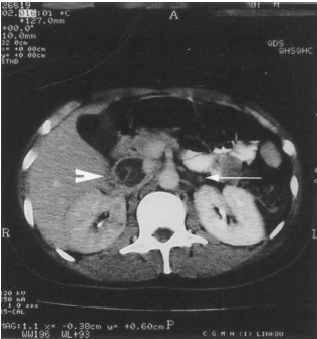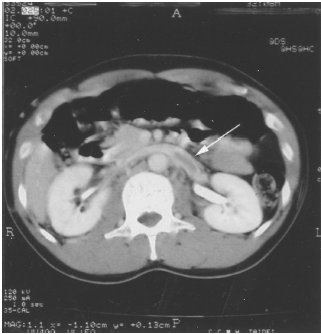INTRODUCTION
Renal vein thrombosis is frequently associated with primary membranous glomerulonephritis with nephrotic syndrome.Citation[[1]] Recurrent renal vein thrombosis is not uncommon.Citation[[2]] Prolonged usage of anticoagulant is necessary in many patients with recurrent renal vein thrombosis, even the primary glomerulonephritis is in remission. Life long administration of Warfarin is not free of complication and troublesome for the patients. Tacrolimus™, formally as FK506, is an immunosuppressant for solid organ transplant. It has also been effective in the treatment of primary glomerulonephritis in recent study.Citation[[3]] In addition to its immunosuppressive effect, FK506 was found to have anti-thrombotic effect in rat.Citation[[4]] It is very interesting to know if FK506 can exert its combined immunosuppressive and anti-thrombotic effect in patients with membranous glomerulonephritis complicated with renal vein thrombosis.
We reported a 31-year-old male with relapsing idiopathic membranous glomerulonephritis complicated with recurrent renal vein thrombosis. The glomerulonephritis was steroid-resistant, cyclophosphamide-resistant and partial responsive to cyclosporine. FK506 was prescribed for his relapsing glomerulonephritis and recurrent thrombotic complications. Six months of FK506 therapy successfully relieved the nephrotic syndrome and renal vein thrombosis. He remains in remission and anticoagulant-free one year after withdraw of FK506. It suggested that FK506 might be an effective agent for the treatment nephrotic syndrome complicated with renal vein thrombosis.
CASE REPORTS
A 31-year-old male came to our hospital due to severe edema in 1995. Initial laboratory examinations suggested nephrotic range proteinuria. Renal biopsy revealed membranous glomerulonephritis. He started to take high dose steroid (1 mg/kg/day) after the diagnosis. The proteinuria was resistant to the treatment. Sudden onset of gross hematuria and severe left flank pain occurred in January 1996. CT scan revealed venous thrombosis in IVC (inferior vena cava) and renal vein (). Nephrotic syndrome and thrombotic complications improved after giving heparin infusion. Cyclophosphamide was given in combination with steroid and anticoagulant. Repeated MRA (magnetic resonance angiography) revealed no evidence of thrombosis in IVC and renal vein. Proteinuria persisted without thrombotic complication under this regimen. However, an episode of upper gastrointestinal bleeding due to gastric ulcer bleeding appeared during the treatment course. We shifted the regimen to the cyclosporine alone therapy to spare the steroid and anticoagulant adverse effect. Cyclosporine therapy for 18 month failed to complete remit the proteinuria and hematuria, but patient was free of thrombotic complication during the treatment period. We stop the cyclosporine therapy to avoid the chronic cyclosporine complications in stable clinical condition.
Severe left flank pain and gross hematuria developed suddenly 6 months after withdrawal of cyclosporine. Bilateral lower extremity edema appeared in the same time. Spot urinalysis revealed proteinuria (> 500 mg/dL) and hematuria (RBC>100/HPF). Normal serum cretonne (1.2 mg/dL), hypoalbuminemia (2.2 g/dL) and hypercholesteremia (324 mg/dL) were found in biochemistry tests. Hemogram showed anemia (Hemoglobin 9.9 g/dL) and normal platelet count (172 K/µL). The prothrombin time and active partial thrombin time were well within normal comparing to the control value. Fibrin was elevated with a value of 513 mg/dL (reference value 115–325 mg/dL). Anti-thrombin III was low (40% of normal pool data; 80–125). The results indicated the hypercoagulation status of the patient.
Recurrent renal vein thrombosis was diagnosed by computer tomography (). He received FK506 3 mg twice daily to treat the glomerulonephritis and renal vein thrombosis is the same time. The flank pain, hematuria and proteinuria disappeared within one month of therapy without anticoagulant. We tapered FK506 dosage gradually and stop all the medications after 6 months of therapy. He remains symptom- and proteinuria-free one year after cessation of FK506.
DISCUSSION
Treatment of primary membranous nephropathy is controversial although there are some evidence-based recommendations to use steroid and cytotoxic agents as the first line regimens and to use cyclosporine for those refractory to above regimens.Citation[[1]] Management of idiopathic membranous nephropathy with FK506 is debatable, because there were some case reports of de novo membranous nephropathy develop in transplant graft after FK506 treatment.Citation[[5]] There were also some successful examples of treating membranous nephropathy with FK506 both in human or experimental animals.Citation[[3]], Citation[[6]]
Thromboembolic complications, especially renal vein thrombosis, are frequent in nephrotic syndrome in general and in membranous nephropathy in particular.Citation[[1]] Anticoagulant therapy remains to be the golden standard but the duration of treatment is not yet determined. The anticoagulant therapy is not free of complication. Our patients developed upper gastrointestinal bleeding under anticoagulant therapy. FK506 is less associated with vascular thrombosis comparing to cyclosporine in transplanted cardiac graft in human.Citation[[7]] Anti-thrombotic effect of FK506 has also been shown in rat.Citation[[8]]
Our patient had idiopathic membranous nephropathy with initial presentation of nephrotic syndrome and renal vein thrombosis. Steroid and cyclophosphamide failed to remit the glomerulonephritis. Prolonged anticoagulation with warfarin was complicated with gastrointestinal bleeding. We gave cyclosporine for his un-remitted glomerulonephritis. Nephrotic syndrome and renal vein thrombosis happened again after cyclosporine was stop. We tried FK506 rather than use cyclosporine because we thought FK506 is a potent immunosuppressant, which can treat idiopathic membranous nephropathy as effective as cyclosporine. Besides, FK 506 was less thrombogenicCitation[[4]] and even had additional antithrombotic effect.Citation[[8]] By the use of FK506 we might spare the anticoagulation agents and obviated the bleeding diathesis of warfarin.
The pathogenesis of idiopathic membranous nephropathy is controversial. FK506 has a strong inhibitory effect on the development of autoimmune glomerulonephritis and Heymann's nephritis.Citation[[9]] These effects are related to the inhibitory effects of FK506 on lymphocytes. However, the antithrombotic effect of FK506 is contentious. There is an in vitro study demonstrating FK506 enhanced platelet aggregation induced by adenosine phosphate.Citation[[10]] In the other hand, there was in vivo study showed FK506's antithrombotic effect.Citation[[4]] The effect may come from stimulation of endothelial prostacyclin release with little endothelial damage or thromboxane release, which are prominent in cyclosporine-associated thrombotic effect.Citation[[11]] It also has limited effect on promoting the release of serotonin, which is induced by cyclosporine and enhance platelet aggregation.Citation[[10]] Furthermore FK506 has been documented to decrease the blood concentration of tumor necrosis factor, a thrombus promoting agent.Citation[[10]] The accumulating evidences suggested the antithrombotic effect of FK506.
In summary, we reported a patient with primary membranous glomerulonephritis complicated with recurrent renal vein thrombosis. He was successfully treated by FK506 alone. The good response indicated a possible role of FK506 in treating membranous glomerulonephritis complicating with thrombotic diseases. Further study is mandatory to confirm the effectiveness of the therapy.
REFERENCES
- Norman M. Management of Idiopathic Membranous Nephropathy: Evidence Based Recommendation. Kidney Int. 1999; 55: S47–S55
- Llach F. Hypercoagulability, Renal Vein Thrombosis, and Other Thromboembolic Complication of Nephritic Syndrome. Kidney Int. 1985; 28: 429–439
- McCauley J., Shairo R., Ellis D., Igdal H., Tzakis A., Starzl T.E. Pivotal Trial of FK506 in the Management of Steroid-Resistant Nephritic Syndrome. Nephrol. Dial. Transplant 1993; 8(11)1286–1290
- Toshiaki M., Yasuto S., John C.G. Antithrombtic Effect of FK506 Versus Pro-Thrombotic Effect of Cyclosporin In Vivo. Transplantation 1995; 60(3)308–310
- Lai S.M., Luger A.M., Hashefi M., Ross G., Jr. De Novo Membranous Glomerulopathy in a Renal Transplant Patient Treated with FK506. The First Reported Case. International Journal of Artificial Organs. 1997; 20(7)379–382
- Koabayashi M., Muro K., Yoh K. Effects of FK506 on Experimental Membranous Glomerulonephritis Induced by Cationized Bovine Serum Albumin in Rats. Nephrol. Dial. Transplant. 1998; 13(10)2501–2508
- Ronald F., Jeffrey A., Alan G., Valantine F., Juan B. Antithrombotic Effect of FK506 vs. Cyclosporin in Cardiac Transplant Recipients: Potential Implications in Transplant Arteriopathy. The Journal of Heart and Lung Transplantation 1999; 18(12)1228–1231
- Keiju H., Junichi H., Yoshito T. FK506 Inhibits Renal Glomerular Thrombosis Induced in Rats by Nephrotoxic Serum and Lipopolysaccharide. Kidney Int. 1994; 45: 1572–1579
- Matsukawa W., Hara S., Yoshida F. Effects of a New Immunosuppressive Agent, FK506, in Rats with Heymann Nephritis. Journal of Laboratory and Clinical Medicine 1992; 119(2)116–123
- Benigni A., Morigi M., Perico N. The Effect of FK506 and CyA on Endothelial Cell Function and Renal Vascular Resistance. Transplantation 1992; 54: 775–780
- Janusz M., Arsalan A., Ewa C., Akikazu T., Michal M., Wlodzimierz, Buczko. The Effect of Tacrolimus and Cycloserine A on Peripheral Serotonergic Mechanisms in Uremic Rats. Thrombosis Research 1996; 83(2)175–181

